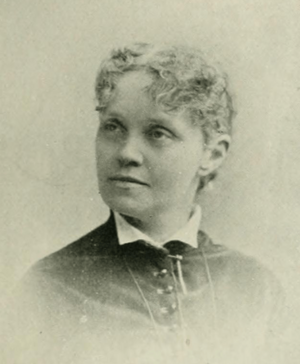Harriet Maxwell Converse facts for kids
Harriet Maxwell Converse (born Harriet Arnot Maxwell) was an amazing American writer, poet, and historian. She had Scottish and Irish family roots. Her Seneca clan name was Gayaneshaoh, and her tribal name was Ya-ie-wa-noh, meaning ‘she watches over us.’
Born on January 11, 1836, Harriet became very interested in the Iroquois people. The Iroquois were a group of six Native American nations in New York State and Canada. Harriet became a strong supporter of the Seneca people and other Iroquois tribes. She helped them keep their lands and traditions alive. Because of her important work, the Seneca people made her a member of their tribe. They even gave her an honorary title, like a chief, for the Six Nations.
In 1897, Harriet helped the New York State Museum buy many Iroquois artifacts. These were important historical items from private collectors and tribes. She also gave her own family's collection, which was over a hundred years old. She even convinced the Onondaga to give their historic wampum belts to the state museum for safekeeping.
Contents
Harriet's Early Life
Harriet Arnot Maxwell was born in Elmira, New York, in 1836. Her father, Thomas Maxwell, cared deeply about Native Americans in New York. He was also active in politics, serving in government at different levels. He even became a Congressman! Later, he was a vice-president of the Erie Railroad. Harriet's mother, Maria, was a cultured and educated woman.
Harriet's grandfather, Guy Maxwell, was an Indian trader in Virginia and New York. He moved to Elmira in the late 1700s. Both her father and grandfather were honored by the Seneca people. They were adopted into the tribe to show respect. When Harriet was nine, her mother Maria passed away. Her father sent her to live with relatives in Milan, Ohio, where she went to public school.
Working for the Iroquois People
Harriet Maxwell Converse became more involved in public life after her second marriage. In the late 1860s, she and her husband met Ely S. Parker in New York City. He was a Seneca man who became an engineer. He served with General Ulysses S. Grant during the American Civil War. Ely Parker was very important in the Seneca Nation and in New York politics.
With Ely Parker's help, Harriet learned a lot about the Seneca people. She felt inspired to defend their rights. She used her wealth and support to help them politically. She also worked hard to preserve their unique culture.
Becoming Part of the Seneca Nation
In 1885, Harriet Converse was formally adopted by a Seneca family from the Snipe Clan. This was a special honor.
She also became a writer. In 1883, she published her first book of poems called Sheaves. It was very popular and had several editions. She also wrote a long poem called The Ho-de-no-sau-nee: The Confederacy of the Iroquois in 1884.
Harriet wrote many non-fiction articles for magazines and newspapers. Some of her historical books include The Religious Festivals of the Iroquois Indians and Mythology and Folk Lore of the North American Indians. These books helped share knowledge about Iroquois traditions.
Fighting for Land Rights
In 1891, Harriet Converse joined a group in Albany, New York. They went to oppose a bill called the Whipple Bill. This bill wanted to break up communal Native American land into small pieces for individual families. It was similar to a federal law called the Dawes Act. The goal was to make the Iroquois farm like European-Americans and break up their reservations.
Harriet helped defeat this bill in the state assembly. The Iroquois had invited her to sit in their Six-Nation Council in Albany. This was a huge honor! No white woman, except Mary Jemison (who was adopted by the Seneca as a young woman), had ever been honored this way.
After the bill was defeated, the Seneca National Council met at Carrollton, New York on the Allegany Indian Reservation. In 1891, they officially made Harriet Converse a member of the Seneca Nation. They named her Ya-ie-wa-noh, after the wife of their famous chief Cornplanter.
In 1892, the Onondaga Nation gave her the position of sachem. This meant she took the place of a chief who had passed away. She was then considered an honorary chief of all Six Nations.
Preserving Iroquois History
One of Harriet's most important contributions was helping to save Iroquois artifacts. Many of these items are now kept safely at the New York State Museum in Albany and the American Museum of Natural History in New York City.
In 1897, she received money to buy artifacts from private collectors and tribes. She also donated her own family's collection, which included items that were over a century old. She convinced the Onondaga people to let the New York State Museum keep their historic collection of wampum belts. These belts were very important for remembering the history of the Five Nations.
In 1902, Harriet Converse spoke out against a federal bill in New York City and Washington, D.C. She helped stop this bill from passing. It would have forced the Seneca to pay a huge amount of money, $200,000, to settle an old claim from the Ogden Land Company.
Harriet's Personal Life
Harriet Maxwell married George B. Clarke in Ohio. He was a part owner of the Congress Spring in Saratoga Springs, New York. George passed away when he was still quite young. Harriet inherited his estate. She also inherited money from her father in 1864, who was a vice-president of the Erie Railroad. This made her independently wealthy.
In 1861, Harriet, who was now a widow, married again. She married Franklin Buchanan Converse, whom she had known since childhood. Franklin was a musician, inventor, and writer. Harriet did not have any children from either marriage. The couple traveled a lot for several years.


